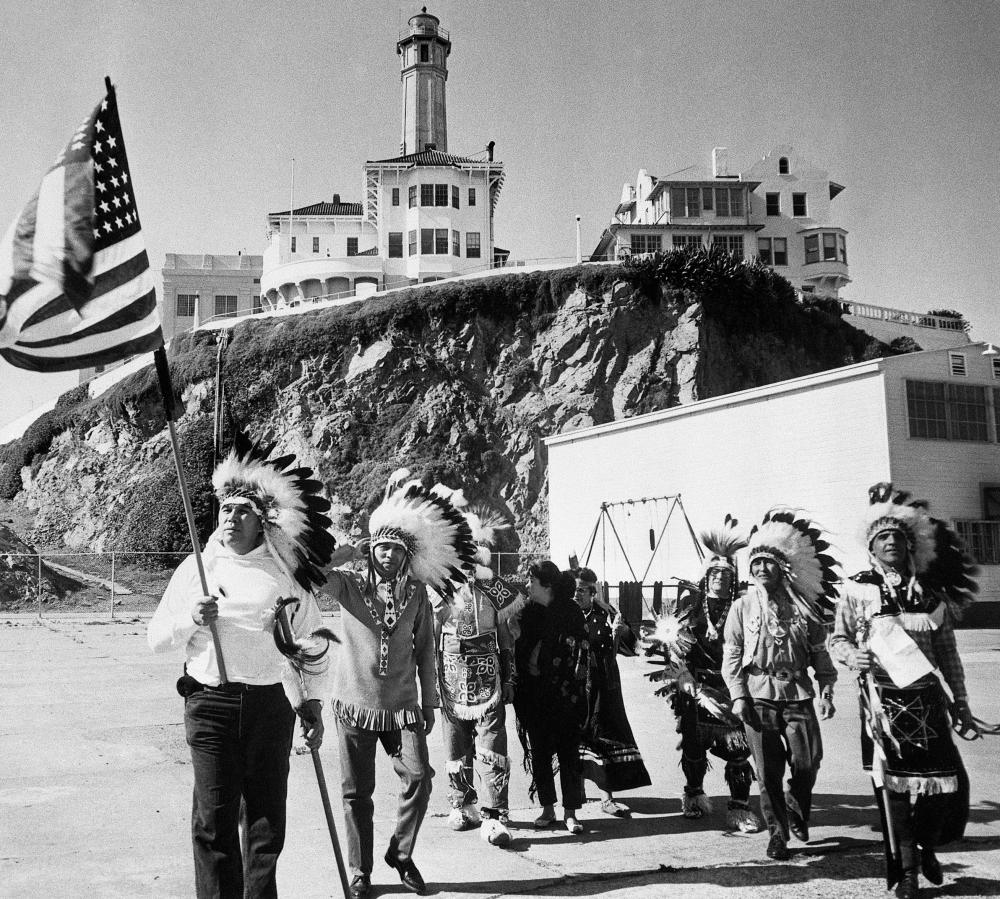When Donald Trump pledged to reopen the notorious Alcatraz prison as a detention center for immigrants and violent offenders, the idea was met with contempt and mockery. San Francisco leaders have called it Trump’s “stupidest idea yet” and threatened to cut off the island’s sewage and garbage services if the president acts on his carceral ambitions.
But for the Indigenous people of the San Francisco Bay Area, the idea was more than just laughable. It was an affront to their identity, and an attempt to erase the island’s history as a site of Indigenous resistance.
After the federal prison shut down in 1963, the island took on a second life as the scene of one of the most important acts of Native American resistance in modern history. Between November 1969 and June 1971, Indigenous activists occupied Alcatraz for 19 months, demanding rights and resources for Native people.
Now, as Trump appears set on pushing ahead despite the extraordinary costs and logistical hurdles, tribal members are fighting to preserve a history that is still little-known beyond Indigenous circles.
Related: A hard cell? Alcatraz tourists dismiss Trump’s ‘insane’ plan to revive it as a prison
Alcatraz has always loomed large for April McGill. Growing up in Mishewal Wappo territory in California’s Sonoma county, McGill, who is a member of the Yuki and Wappo tribes, frequently heard stories from the veterans of the occupation who lived in her community. Her aunt even babysat the children of Richard and Annie Oakes, who led the movement.
When she moved to San Francisco as a teenager, the island’s shadow grew – especially as McGill, who is now executive director of the city’s American Indian cultural center, became increasingly involved in activism herself, and learned about the pivotal role the occupation played in maintaining Native sovereignty in California and nationwide. “It holds a really personal, deep place to me,” McGill said. “It symbolizes so much of our history.”
McGill and other Indigenous leaders from the San Francisco Bay Area were appalled when the Trump administration confirmed its plans to reopen the island, even sending a delegation out to tour the shuttered facilities in July.
Beyond erasing the historical significance the island holds for Native peoples, McGill says that the notion of using the site to pursue the president’s anti-immigrant agenda hearkens back to the state’s history of violence against Indigenous groups – and that any actions the administration takes will be met with pushback from the community.
“[They want to use it as a] place to commit inhumane violence against people who are here trying to escape violence,” McGill said. “It’s very retraumatizing. It wasn’t that long ago that we were violently displaced and put in camps. We see this as a repeat of that history.”
Most of these criticisms of Trump’s plan focuses on the cost of refurbishing the site, which was shuttered more than 60 years ago – instead becoming a historical landmark and tourist destination run by the National Parks Service since 1972 – precisely because the infrastructure had become too expensive to maintain. Estimates put the cost of modernizing the facility at as much as $2bn, to which San Francisco’s Mayor Daniel Lurie responded that the city “could use that funding to keep our streets safe and clean”.
But for Indigenous leaders, the proposal’s audacity goes beyond its hefty price tag.
According to Virginia Hedrick, executive director of the California Consortium for Urban Indian Health, Trump’s aims undermine Alcatraz’s status as a “beacon of resistance” for Indigenous people in California and nationwide. That’s because the 1969 occupation was more than a symbolic act of defiance – it spurred meaningful changes in federal policy with regards to Native sovereignty and support for tribal nations.
“What came out of the occupation were tangible things,” Hedrick said, pointing to the development of California’s Indian health delivery system, which she says was floundering before protesters on Alcatraz demanded better healthcare. “This movement was about honoring the treaties, making the federal government make good on its promises.”
It was in response to the occupation that President Richard Nixon shifted the federal policy on Native treaties from “termination” to one of “self-determination” for Native peoples, echoed the writer and film-maker Julian Brave NoiseCat, who grew up in the Bay Area and descends from British Columbia’s Tsq’escen and Lil’Wat First Nations.
As a teenager, NoiseCat spent Thursday evenings at East Oakland’s Intertribal Friendship House practicing powwow drum and dance. At the end of the night, he said, participants would gather and sing the American Indian Movement song. “We would sing that song to carry forward the movement that had begun at Alcatraz and that endures to this day,” he said.
To NoiseCat and others, the lack of acknowledgment of these histories in current discussions about Alcatraz’s future illuminates broader issues of Indigenous erasure. “For me, Alcatraz represents the starting point of the Native rights movement,” he said, calling the occupation the “Montgomery bus boycott of Indigenous rights”, in reference to the seminal civil rights protest.
That erasure extends to discussions of how federal dollars could be better spent. Core goals of the Alcatraz occupation included establishing an Indigenous cultural center and college, explained McGill. Today, the cultural center she runs can’t afford a brick-and-mortar homebase in San Francisco, forcing it to operate virtually. “Give that money to American Indian people so that we can have a cultural center, so we can create housing,” she said, adding that Indigenous people have among the highest rates of homelessness, health disparities, and incarceration in San Francisco. “And yet, we’re always the last at the table,” she said.
For Hedrick, a member of California’s Yurok tribe, that repeated dismissal is “par for the course” considering the Ohlone people – the tribe indigenous to the lands of the Bay Area, including the island of Alcatraz – remain federally unrecognized. “The federal government is proposing rebuilding, resurrecting a prison, estimated to cost hundreds of millions of dollars, while continuing to overlook the Ohlone people,” Hedrick said. “That is complete Indigenous erasure right there.”
Hedrick is committed to ensuring that the Indigenous ties to Alcatraz are central to the island’s public perception. She makes a point of visiting the island at least a few times every year to teach about the American Indian Movement. And she emphasizes that the island is home to important cultural events, including a sunrise gathering that takes place every October for Indigenous Peoples Day.
She says that if the administration moves forward with reopening the island as a prison, the community is prepared to fight back. “We’ll see communities gather again,” she said. “We have attorneys, we movement-building organizations in California who will organize and work in lockstep.
“We’ve come a long way.”

